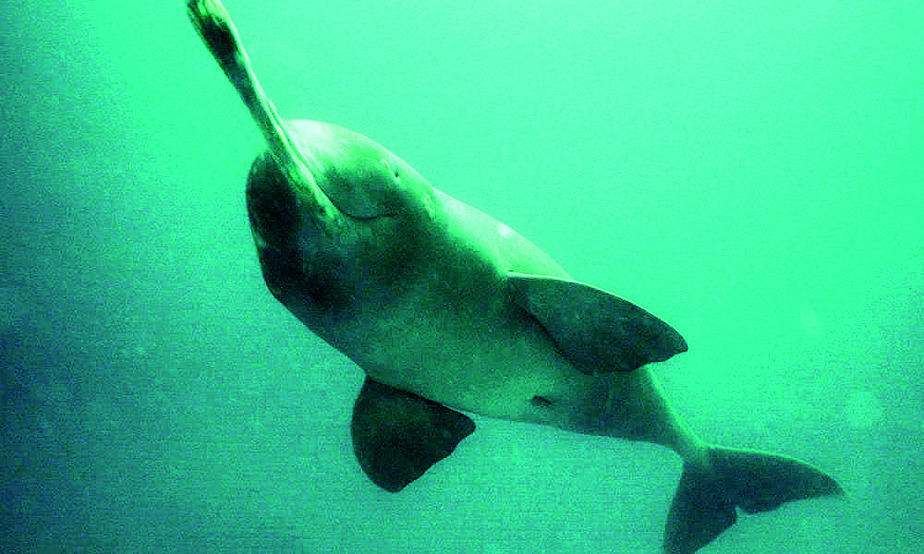There may not be too much of a difference between the Gangetic Dolphin and those who make the policy decisions for its conservations – both swim blind
There might just be a caste system among our National Symbols that we didn’t know about. The Gangetic Dolphin has been our National Aquatic Animal for just nine years, and it has been an endangered species throughout this period. Or, that’s what we believe. That’s because there hasn’t been a scientific census of the population of Gangetic Dolphins. The efforts at counting the dolphins which are underway at the moment may be a good start, but they may just fall short of meeting the purpose of preventing the Gangetic Dolphin from becoming the first of our National Symbols to disappear.
Platanista gangetica is how the biologically inclined know it. Others call it the ‘side-swimming dolphin’ or the ‘blind dolphin’. It is also known by the quirky name of ‘Susu’ in some parts because of the sound it makes when it surfaces to breathe. The Gangetic Dolphin is found only in India, in the massive river system that is the Ganga-Brahmputra belt. They are concentrated in the states of Uttar Pradesh, Bihar and the Chambal regions. Some of these stretches are deemed to be of ‘international importance’ to global conservation efforts like the Ramsar Convention on Wetlands’ Conservation.
As the National Aquatic Animal, the Gangetic Dolphin is no different in the eyes of the law than the Royal Bengal Tiger or the Gir Asiatic Lion or the Asiatic Elephant. The Gangetic Dolphin has been classified as ‘endangered’ by the International Union for Conservation of Nature (IUCN) since 1996. That’s a whole 13 years before it was declared the National Aquatic Animal. Conservationists had at the time been optimistic that the wrapping of the tricolour around the dolphin would help it rebound from the face of extinction.
Ironically, there has been no Supreme Court order making it compulsory to save this National Symbol.

No scientific survey has been conducted so far to get an accurate count of the dolphins that survive in the wild. Normally, scientific methods of counting involve the use of sonar sensors called hydrophones that identify individual dolphins by the sounds they make, which are as unique as fingerprints.
A ‘winter survey’ is underway right now, and is attempting to bridge the ‘unscientific’ methods of counting that have been employed so far. This will be followed by a ‘summer survey’ to verify the winter results.
“There are no more than 2,500 dolphins in India according to local estimates. The international bodies estimate even less: about 1,200-1,800 individuals. The earlier censuses were based on random sighting of dolphins. People in the region, or even surveyors for that matter, would spot a dolphin leaping out of the water for air, and count it. There has been a lot of double counting and not to mention, the vast measure of inaccuracy,” says Qamar Qureshi, a wildlife ecologist who specialises in river-dolphin conservation at the Wildlife Institute of India (WII).
The current survey spearheaded by Qureshi and conducted by the WII, which began in January, is different from all previous attempts because it is being conducted on standardised protocols developed by the WII. Qureshi said that special gadgets including those that could see well below the surface of the water are being deployed. However, hydrophones could not be deployed thanks to the vastness of Ganga at some places, says Sandeep Behera, a consultant in the Biodiversity Programme of the National Mission for Clean Ganga.
While there might be a heavy deployment of funds, not all is being diverted to the estimate and conservation of species, warns Sinha. “The WII is being sanctioned Rs 23-25 crore for the census. What is the point of it if they don’t even develop and use proper hydrophones?” he says.
Independence has meant little to our National Aquatic Animal. Their numbers have halved since we became ‘free’, says Qureshi.
The dolphins have been affected badly due a host of anthropogenic factors. That means ‘human’ factors. They have also lately been taking a beating because of climate change. “Anthropogenic disturbances have been nothing short of a death-knell to the dolphin population in India,” says the ‘Dolphin Man of India’, also known as Ravindra Kumar Sinha, Vice Chancellor for Nalanda Open University.
“Besides the deliberate killing of dolphins for oil, and the accidental killings through fishing nets, growing urban centres around the Ganges, overfishing leading to a loss of prey base, water development projects, dams and barrages and pollution have nearly wiped the population out. The factors need to be checked and suitable policy measures need to be drafted,” added Sinha, a recipient of the Padma Shri for his efforts.
But what has probably hurt the dolphins more is straight out of an episode of the television show ‘Satvameva Jayate’. “The carcinogenic compounds present in fertilisers and pesticides being washed into the river are leading to an increased observance of cancer,” says Dolphin Man Sinha. This has caused infertility, which means the dolphins are just unable to get pregnant. The Gangetic Dolphins gives birth to one calf in two to three years. Imagine if even that fails to happen.
If all these pain points are not addressed, the Gangetic Dolphin could meet the same fate as the baiji — the dolphins of the Yangtze River in China, which are now extinct.
Besides the want for a realistic policy response, the ineptitude of the forest department has been another major contributing factor in the conservation of riparian species in the country. “The dolphins are found in the region between Hastinapur Wildlife Sanctuary; Brijghat to Narora Stretch in Uttar Pradesh; Bijnor and Narora barrage; from the region right after the confluence of Yamuna in Allahabad, all the way to Varanasi. None of these regions are in the ‘protected areas’, so there are no efforts being made towards conservation. The existing sanctuary at Vikramshila in Bihar is where they fall under the protected area. Even here, forest department personnel are neither trained nor adequately equipped to be able to effectively conserve them. The story is true across species, but at least in the case of terrestrial animals there are some measures like camera traps and constant foot or jeep patrolling that can help. How does one patrol inside the river to conserve the riparian species?” points out MS Ananthakumar, a retired senior official of the Indian Forest Service, the less glamorous IFS.
To make all of this worse, climate change has created an urgency for the need to conserve these gentle beasts, an urgency that is yet to crystallise into action. “Ganga relies heavily on monsoon rains and glacial melt water. A changing climate is prone to bringing more droughts or floods. The dolphins give birth to one calf in two to three years. The flooding or drought, depending on how the year is, has led to an added stress for these gentle cetaceans which are breeding even lesser than they usually do. Not to mention the habitat loss,” says Dolphin Man.
While all of this activity happens in government, efforts might be too little and too late, say experts. “We have seen in a variety of species from musk deer to hanguls that the road from preliminary census to actual conservation is often long-winded and narrow. By the time policies are drafted, funds are deployed and local communities are sensitised, it just might be too late. The dolphins are an apex predator of the Gangetic waters. Their wellbeing indicates the status and the health of the entire river ecosystem. Dolphins cannot be conserved outside their natural habitat. The habitat has to be conserved, else we are heading towards an inevitable disaster,” says Kangana Kaul, a wildlife researcher who was involved with the government’s failed captive-breeding efforts for the hangul, the Kashmiri deer.
A census is underway and immediate efforts are needed to ensure our grandchildren get to see the Gangetic Dolphin. The first total loss of a National Symbol is one thing. We are still unsure what sins the Gangetic Dolphins have committed, that even Ganga maiyya can’t wash away.





